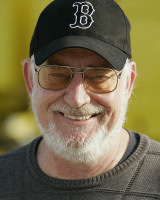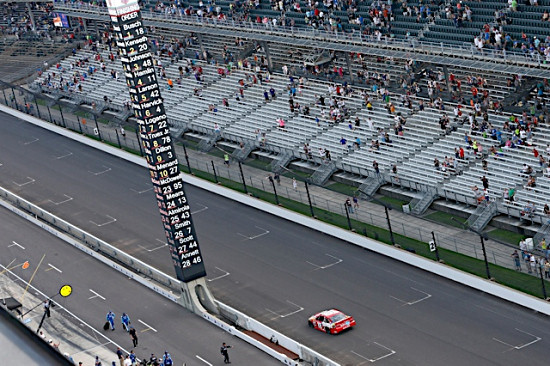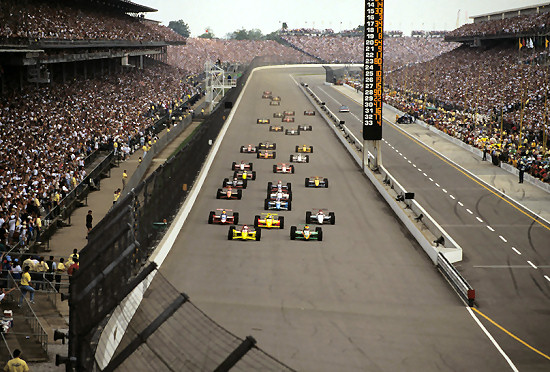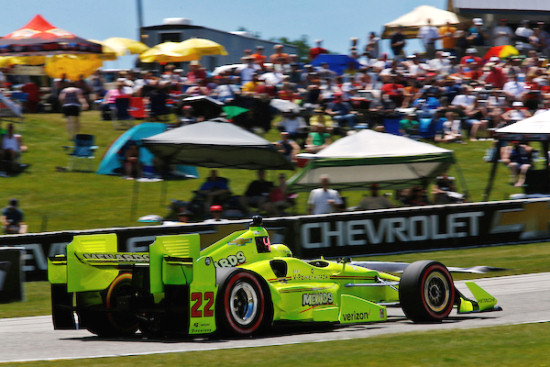The Way It Is/ Grappling with racing's declining popularityby Gordon Kirby |
 Most forms of professional motor racing around the world are struggling these days with declining popularity. Whether it's Formula 1, NASCAR, IndyCar, IMSA or the World Endurance Championship outside Le Mans, crowds at most races, TV ratings and overall media coverage have been falling off for a few years. No matter what type of paddock or garage area I find myself in it's impossible to avoid a barrage of questions about what can be done to turn the tide.
Most forms of professional motor racing around the world are struggling these days with declining popularity. Whether it's Formula 1, NASCAR, IndyCar, IMSA or the World Endurance Championship outside Le Mans, crowds at most races, TV ratings and overall media coverage have been falling off for a few years. No matter what type of paddock or garage area I find myself in it's impossible to avoid a barrage of questions about what can be done to turn the tide.
In recent weeks we've seen shockingly poor crowds for NASCAR races at Indianapolis and New Hampshire. The Brickyard started well but has fallen on hard times in recent years with no sign of any turnaround. New Hampshire also enjoyed good crowds for many years for both its summer and fall NASCAR races but the numbers have been declining steadily in recent years with last month's race representing a significant drop-off. NHMS is the only major speedway in New England, a region of the country with a long history of short track stock car and modified racing and a strong NASCAR fan base. So last month's dismal turn-out at NHMS was extremely discomfiting. Meanwhile, Formula 1 has drawn equally poorly for recent Grands Prix at the Red Bull Ring in Austria and the Hungaroring. Nor was the crowd very strong at Hockenheim through the two days of practice and qualifying.  © Nigel Kinrade There was also a very weak crowd at the recent Nurburgring Six Hours WEC race featuring factory teams from Porsche and Audi while here in America IMSA is struggling to draw crowds at places like Laguna Seca and Watkins Glen. The DTM in Germany and central Europe stands out as a longterm success story with strong factory competition from the likes of Mercedes, Audi and BMW as well as big crowds and media coverage. Another bright spot around the world is Australia's V8 Supercar championship with factory-backed cars from Ford, Holden, Mercedes, Nissan and Volvo. With major events like the Bathurst 1000Ks, the Aussie tin top series also draws big crowds and plenty of local media coverage. In recent decades vintage and historic racing has emerged as one of the healthiest forms of motor sport around the world. Vintage and historic racing is booming here in America and Canada, in the UK, across Europe and in Australia and New Zealand with plenty of events and participants and happy crowds. While contemporary professional racing has fallen into a funk, historic racing has become an increasingly important part of the overall health of most of the world's permanent road courses and some oval tracks too. Another point is that motor racing as a whole enjoys wider popularity and a greater pool of participants across the United States and around the world than ever. Semi-pro and amateur racing continue to flourish amid a seething cacophony of categories, classes and sanctioning bodies of which there are more than 220 at last count in the United States alone. We're also witnessing a booming classic and collector car market these days. One example is the proliferation of more than fifteen auctions which are as much a part of this month's Monterey Historic weekend as the Reunion races at Laguna Seca and the renowned concours d'elegance at Pebble Beach. It's sad and a little mystifying that none of this broader enthusiasm for cars can be translated to professional racing's struggling big leagues. Recently, I enjoyed an interesting conversation about the state of the sport with John Menard who ran his own Indy car team from 1988-'99. Menard's team raced turbo Buick V6 engines and then his own Menard engines through 1996. Arie Luyendyk and Scott Brayton qualified Menard's Lola-Menards on the front row at Indianapolis in 1995 and Tony Stewart won the 1997 IRL championship driving a Menard GForce-Oldsmobile. Menard returned to Indianapolis in 2016 as the sponsor of Simon Pagenaud's Team Penske Dallara-Chevrolet.  © Paul Webb "I think when I was racing at Indianapolis in the late eighties and early nineties what was right about it was you could do your own thing," he observes. "There were a lot of different formulas and combinations you could bring to Indianapolis. It was kind of run what you brung and I think that's what made Indianapolis great. It was about people doing their own thing and setting new track records. It was all about speed. "The race was important but in some ways the race was a little bit of an afterthought. It was the last thing you did and the rest of the month was about speed and posturing. Speed was the big deal and somewhere along the line we've lost that. "There are some practical reasons for that. The g-loads these days are just unbelievable and if we had kept going faster and faster, the cars would be just too fast and the lawyers and insurance people wouldn't like that. But it sure was fun while it lasted." Menard was an early supporter of the IRL but he believes a critical mistake was made by removing the spirit of innovation from the sport amid a necessary attempt to restrain speeds. "I think what was wrong was our failure to come up with a different way of controlling the speeds and the terminal velocity dictated by improvements in safety," he said. "Instead, we came up with more and more restrictive formulas. "Right now from an innovation standpoint Indy is no damn fun at all. Participating in the last Indy 500 as a sponsor with Team Penske was an eye-opener for a guy who had been gone for some years. It's totally about computers and fuel mileage and what demands you can put on the engine. It was a chess game. I was there with the best guy. The Penske operation is unbelievable. To watch that from the inside was a pleasure. It was great.  © Gary Gold "It was fun. It was still Indy. But it wasn't about racing in the old sense. It was all about computers and fuel management. But in the end, it was a simple spark plug failure that cost us the race. Some things never change." Menard pointed out that another thing that has changed dramatically is the attitude towards safety. "It probably takes a very different driver to drive today's cars," he remarked. "I don't think most of the drivers today could be successful in the old Indy cars. Some of them could be for sure, but not many of them. "First of all, they would be shocked at the level of safety. I swear the guys from the old days didn't care about safety but in today's world we've become much more aware of safety in everything you do in life. And really, the improvements in safety had to happen because many great drivers perished over the years. That was the dark side of the sport. That side has gotten a lot better and rightfully so. It had to happen." Menard was impressed by the turn-out for this year's 100th Indy 500 and hopes the big race will continue to do well in the coming years. "I think the worm has turned," he declared. "I think what they did at the 100th Indy 500 was astounding. They drew a great crowd and put on a tremendous event and it will be interesting to see what the next few years bring. I think it's certainly theirs to lose as this point. "If they keep doing the same thing at the Indy 500 for a few years in a row then they've definitely got something. A lot of people said it was because it was the 100th running, but I think it was bigger than that. They did a great job of promoting it and they need to keep doing the same job because it was successful."  © LAT USA "I thought that was one of the best races I've ever attended," he remarked. "It was great to see a big crowd and tremendous enthusiasm. They had chamber of commerce weather and the place was packed. I think it showed that IndyCar needs to go back to the great road courses. Those cars look good on road courses and they should race on more tracks like Elkhart Lake. They never should have left Elkhart and I'm glad they're back there and in a healthy way. "It was great to see and, like Indianapolis, they also need to keep doing the same job. I know George Bruggentheis was surprised with the response. It was better than he expected. They drew a great crowd and it was more than just a race. It was an event and that's what you need. They ran another race after the IndyCar race and that helped because some people stayed and some left. Everybody didn't try to run out the door at the same time so the traffic ran smoothly at the end of the day. "So I think IndyCar needs to keep doing what they're doing at Indianapolis and with races like Elkhart Lake, and they're on the right course. They draw well on most of the street courses and all the road courses. Mid-Ohio gets a good crowd and it would be good to see Watkins Glen grow into a strong event. It would be nice to see them race at Laguna Seca again and take a west coast swing up the Pacific coast. They need to be there. Even NASCAR doesn't get up into that part of the country. "It would be good to go where NASCAR doesn't go. Vancouver was a great race and that would be a great place to get back to. Vancouver is a very cosmopolitan city. It's a very international market and would be a great fit for Indy cars. If I had my druthers I'd love to see them go back to Vancouver." Menard is also encouraged by IndyCar's current boss Jay Frye. "I have confidence in Jay Frye," he said. "He's a lot more open-minded than what we've seen there in the past. He's prepared to do things differently. IndyCar has got some good things going for it and they've gone so far down that anything on the upside is good for them." Over the past ten years with his son competing full-time in the Cup series Menard has also been a close observer of NASCAR. He believes NASCAR must make some serious changes to turn the tide of steadily declining crowds and TV ratings, but struggles for solutions to NASCAR's problems. "They're fighting demographics and I think there are too many races and too many long races," Menard commented. "The joke is you turn on the TV, watch the start, go out and mow the grass then come back in and watch the finish. And that's not too far off reality. They've got to do something different and what that is exactly, I don't know.  © Nigel Kinrade "One of the problems is that television coverage is getting better so you can actually enjoy the race more from your couch at home. I can listen to my son better if I watch the race on TV and listen to the NASCAR app than you can when you're sitting on the scoring stand. Yet the TV ratings are suffering because the races are kind of long and boring if your kid's not in it." Despite motor racing's many problems Menard remains a staunch optimist. "I was born and raised on a dairy farm and I thought anything was easier than milking cows," he remarked. "After all the work and effort that's gone into the business, I'm not so sure I believe that. But I think I was born at the right time in the USA. Unfortunately, I think if I had to start the business again with all the regulations the government puts on you, I don't know if I could do it. "So I consider myself very fortunate to lead my life in these times and I really feel fortunate that I got involved in racing because I had a lot of fun and made a lot of friends. I've enjoyed a great life. Let's hope that the best is yet to come." The sport and America as a whole needs more of John Menard's optimism, inspired leadership and keen business and marketing sense. |
|
Auto Racing ~ Gordon Kirby
Copyright ~ All Rights Reserved |
